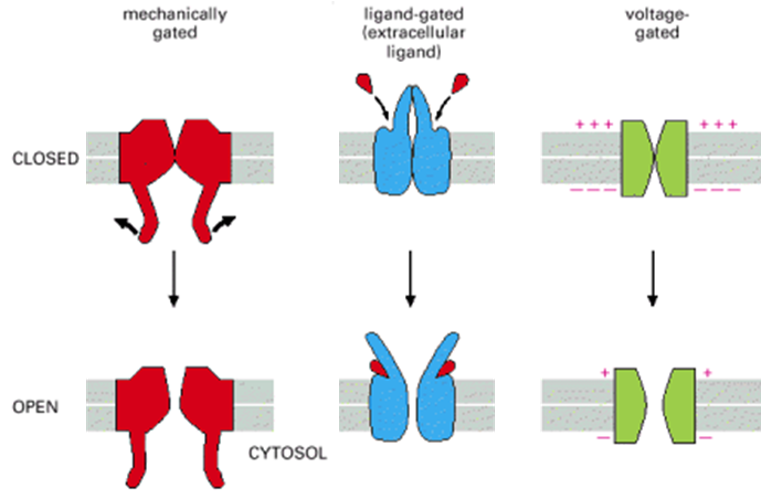Pain pathways and central processes of pain
1/24
There's no tags or description
Looks like no tags are added yet.
Name | Mastery | Learn | Test | Matching | Spaced |
|---|
No study sessions yet.
25 Terms
What receptors can be found cutaneously?
Pain - free nerve endings
Touch - Meissner’s, Merkel, Ruffini, hair root plexus
Deep pressure - Pacinian
What type of ion channels can be found in receptors?
Cell membrane of nerve endings will have either mechanically or ligand gated ion channels
If membrane potential change is sufficient voltage gated sodium channels will be activated→ AP

How do mechanically gated ion channels work in receptors?
Deformation of cell membrane of nerve ending will cause change in shape → open ion pore→ allowing passage of ions across cell membrane → depolarisation of cell membrane
How do ligand-gated ion channels work in receptors?
Bind to receptor → receptor opens up and produce ion pore → depoolarisation of cell membrane at nerve ending
What chemical stimulators affect nociceptors? (5)
•Bradykinin
•Serotonin
•Potassium
•Histamine
•Hydrogen ions
What chemical sensitisers affect nociceptors? (3)
•Prostaglandins
•Substance P
•Nerve growth factor
How is the receptor AP threshold determined?
The initial frequency of action potentials in the nerve fibre is determined by the amplitude of the generator potential in the receptor
Why would a receptor display no adaptation?
it continues to respond to a stimulus at a constant rate over time
provides continuous monitoring of the stimulus
Why would a receptor display slow adaptation?
Responds strongly at the start but then slowly reduces its response
allows body to adjust to ongoing stimuli while still detecting changes if they occur e.g. baroreceptors
Why would a receptor display rapid adaptation?
responds quickly at the start of a stimulus but then stops firing even if the stimulus continues. It is designed to detect changes in the stimulus rather than its constant presence.
Properties of cutaneous receptors - free nerve ending (temp)
Function: temp
Threshold: varies
Adaptation: rapid
Properties of cutaneous receptors - free nerve ending (pain)
Function: pain
Threshold: high
Adaptation: slow
Properties of cutaneous receptors - Meissner’s corpuscles
Function: touch
Threshold: low
Adaptation: rapid
Properties of cutaneous receptors - Merkel disks and Ruffini endings
Function: touch
Threshold: low
Adaptation: slow
Properties of cutaneous receptors - Pacinian corpuscles
Function: deep pressure
Threshold: low
Adaptation: very rapid
What is a receptive field in sensory neurons?
Region of a sensory surface that, when stimulated, causes a change in the firing of the neuron.
What is convergence in the context of sensory neurons?
Process where more proximal sensory neurons (e.g. in the spinal cord, brain stem, thalamus, and cortex) have receptive fields that are composites of the receptive fields of more distal neurons (e.g. primary afferents).
What happens to convergence if high spatial resolution is required?
Convergence will generally be low, meaning a primary afferent will only synapse with one or a few higher-order sensory neurons.
What happens to convergence if spatial resolution isn’t so important?
Convergence can be high, meaning a primary afferent may synapse with a large number of higher-order sensory neurons.
What is nociception?
Detection of noxious stimuli, can often trigger pain
Steps in the pain pathway (6)
Noxious stimuli activates sensory receptor
Axon of sensory neuron synapses with neuron in dorsal horn
Axon of neuron decussates within 1-2 spinal segments
Ascending fibre projects to thalamus in spinothalamic tracts, synapses with neuron in thalamus
Axon of neuron projects to primary somatosensory cortex
Pain felt
Examples of phantom limb pain
in absence of sensory nerve ending e.g. following nerve transection or neuropathy
in absence of first order neuron e.g. following avulsion of dorsal root from SC
in absence of limb
Which neurons/ receptors are essential for pain sensation?
2nd and 3rd order neurons
How does the perception of pain change when you '“rub it better”?
Stimulation of large-diameter sensory neurons can block out the message from pain fibres
Treatment for neuropathic pain
Pharmacological: opioids, antidepressants
Physical: TENS, surgery, touch therapy
Psychological: pain management groups, behavioural therapy